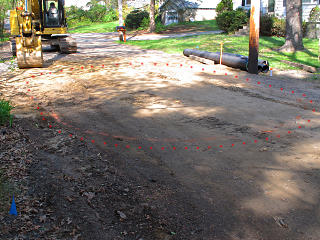
|
The tentative roadwork schedule that the town engineer had distributed
to everyone was already slipping a little, as the rest of the week
after the catch-basins went in had the guys working elsewhere. Then
they seemed to take the Friday completely off, even though it would have
been a really nice day for work. The guys explained later that they
didn't want to tackle this next piece on a Friday anyway, as their
experience says they'll hit the nastiest surprises right at the end
of a week when the town offices close early and nobody can be reached
for problem resolution. So nothing further moved here until the
next Monday.
[Thumbnail pictures are linked to larger ones.] |
Day 3 [a very long one]
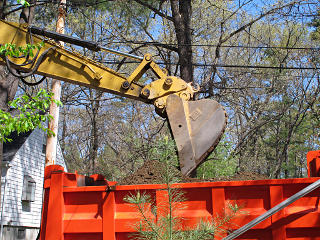
|
He had his challenges cut out for him that morning, with my FiOS fiber right in the way again [the tiny one that looks parallel to the tree]. My power feed above that and all the neighbor's service drops were also part of his headaches that morning. The expected dirt volume would be much larger than for the catch basins and would mostly be replaced with stone, so he wanted to truck most of it away. But to drop dirt into the dumper, he had to swing the bucket in sideways with about a foot to spare between the truck and the fiber, and then dump the bucket very carefully without pulling the boom and stick up too far. |
|
At one point he tried to move forward a little to open the bucket more
toward the front of the truck, hoping that the fiber that was by
necessity resting on the hydraulics
would gently slide back ... but it hung up under the bolt heads at the
end of the cylinder, and I watched in horror as he started to put a
nasty pull on the drop. The other people around saw this too and we all
yelled "YO!!" and whether he heard that or not he stopped and backed
off. The cable is really small, and he could barely see it up through
his cab window. So ... crisis averted, and I still had my internet
connectivity.
FiOS drops don't always get flown from the pole; this one hops off mid-cable and just attaches to the main messenger for the trunk, which even though thus slightly deflected nonetheless provides enough tension against the house attachment to hold everything up. Part of that is because the fiber drop cables come in a variety of fixed lengths with preassembled connectors, so some adaptation has to be made to reach end-to-end and not have too much excess coiled up somewhere, and they don't weigh much so it isn't a lot of sideways pull on the trunk. The fact that such a rig had a lot more overall "springiness" to it probably helped save the drop; if it had been held between two hard points it might well have snapped. | |
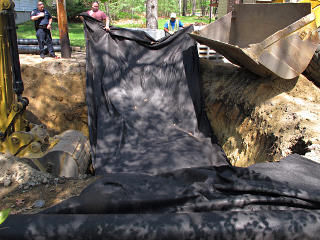
|
After everyone was clear on these additional procedural wrinkles they got
back to work, and with this end of the hole down to depth it was time to
start laying in filter cloth. This would go in under the entire drainage
structure, to help prevent silting of its lowest points.
This immediately had me wondering if I should have done the same on my own little drainage pits. I'd planned for some silt accumulation area by placing the bigger rocks at the bottom but expected crap to come from above, not below. |
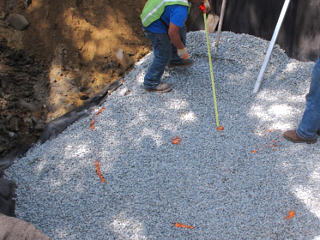
|
They used the "rock drop" trick again to find the center offset, and marked out the 8-foot diameter for placement. |
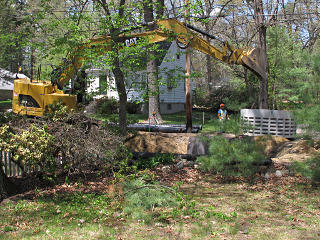
|
I backed way off for this next lift to get the wider picture, because
I figured I knew what was
going to happen. This was the heaviest item because the top half of the
infiltration structure is closed, and thus contains the most concrete of
all the parts here. I should *not* have been able to see the top of the
excavator from this viewpoint, but as the operator tried to lift this
thing out on such a long lever arm the entire digger body started to tip
up. He was also very close to the edge of the hole. I thought I heard
him emit a little "whoa!" from inside the cab ... although he's probably
well acquainted with the dynamics of all this.
In general the structure piece was within manageable lifting limits [PDF brochure, 2.2 Mb] of the excavator, but not *quite* when out at full reach like this which derates capacity to about 4500 pounds even with the machine's "heavy lift" feature enabled. |
| I highly recommend the above-linked brochure as an instructive read for anyone even mildly interested in equipment like this, as the engineering behind it is rather fascinating. The lift limit table is on page 21. There are many videos kicking around about how to operate these things, including the one where a guy has his 6-year-old son digging a drain or something... I spent a little while doing research, learning fun little facts such as the difference between the ISO and SAE joystick control standards, stuff about hydraulic pump controls and maintenance, and how Cat's automatic "grade control" works. This ain't your daddy's rusty old four-lever backhoe, by any means. | |
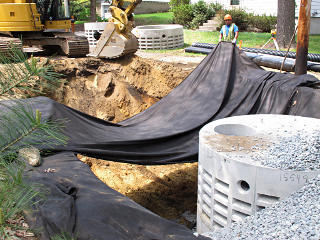
|
The filter-fabric lining was continued in a couple more strips from the giant roll they had. |
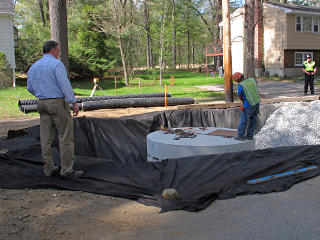
|
A guy from the hired engineering company showed up to inspect some things, and wanted the crew fellow to break off from his stone-pushing to check some heights. There was apparently concern that the top of the structure was a little too high, not allowing sufficient depth of roadbed above. But the last thing anybody wanted to do was pull those structures up again and try to muck around underneath. |
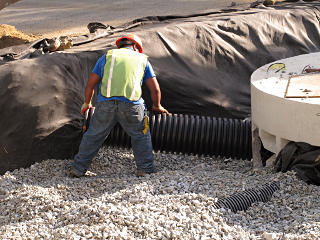
|
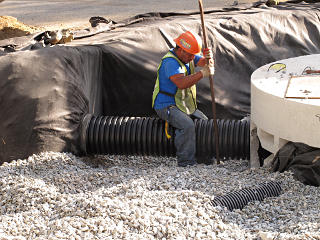
|
| Then he could insert the pipe, and used a clever means of prying it into the rubber fitting far enough to be secure. | |
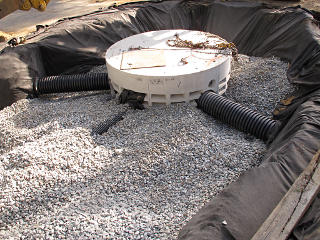
|
With all the pipes laid in, the thing looked just like the design! Funny that. Except that there was probably a lot more drainage stone involved in this than anyone had predicted. |
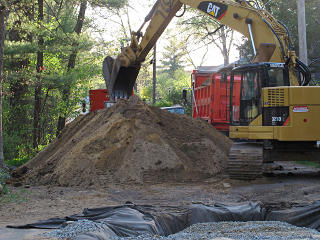
|
There was still a giant mound of dirt in the road, so one guy worked on loading and hauling three or four truckloads of that away while the other finalized the pit and the stone for regrading. |
_H* 140516